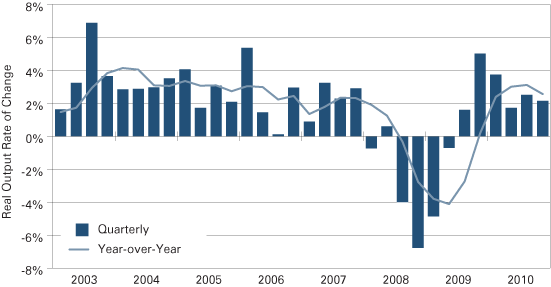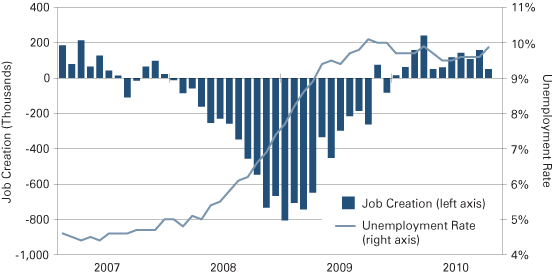U.S. Outlook for 2011
Co-Director, Center for Econometric Model Research, Indiana University Bloomington
Over the past three years, the U.S. economy has been a model of diabolical consistency. During 2008 and the first half of 2009, it produced the worst recession since the Great Depression. During the time since, it has produced the worst recovery since World War II.
As can be seen in Figure 1, the Great Recession (as it is being called) began at the end of 2007. The Business Cycle Dating Committee of the National Bureau of Economic Research recently proclaimed that it ended in June 2009. This dating means that the recession lasted 18 months, the longest since World War II. At its low point (the cycle trough), output in the economy had fallen to 4.1 percent below its pre-recession peak, the largest decline since World War II.
Figure 1: U.S. Real Output Quarterly and Annual Rate of Change, 2003 to 2010

Source: Bureau of Economic Analysis
As shown in Table 1, this output decline is well above twice the average for previous recessions. Adding insult to injury, the “recovery” has been lackluster at best. Over the five quarters since the economy hit bottom total growth has been only 3.6 percent. After more than a year, output is still below its peak, with performance less than half that following previous downturns.
Table 1: Impact of Recession on Output and Employment
| Output | Private Sector Employment | |||
|---|---|---|---|---|
| Peak-to-Trough Decline | Five Quarters After Trough | Peak-to-Trough Decline | Five Quarters After Trough | |
| Average of 9 Post-War Recessions | -1.6% | 7.9% | -2.9% | 3.8% |
| 2007-2009 Recession | -4.1% | 3.6% | -6.1% | -0.5% |
Source: Bureau of Labor Statistics
The employment picture, shown in Figure 2, is even more grim. At the official end of the recession, the private sector had a job loss of 6.5 percent (over 7 million). Following the patterns of the 1990 and 2001 recessions (but unlike earlier recessions), employment continued to decline after the recovery began, with 8.4 million jobs lost between December 2007 and December 2009. During the next 10 months the private sector added about 1.1 million jobs, but this still left employment in negative territory for the first five quarters of the recovery, as opposed to the substantial gains experienced in earlier recessions.
Figure 2: U.S. Job Creation and Unemployment Rate, January 2007 to November 2010

Source: Bureau of Economic Analysis and Bureau of Labor Statistics
And, if all this wasn’t enough, the recovery seems to have lost momentum. After accelerating to growth averaging an annual rate of 4.4 percent in the last quarter of 2009 and the first quarter of 2010, growth over the next two quarters fell off to an average of only 2.1 percent. Private sector job creation reached a relatively healthy 241,000 in April, but since has averaged only 99,000. Unemployment dropped from 10.1 percent in October 2009 to 9.5 percent in June 2010, but has since reversed course, with November 2010 up to 9.8 percent.
Turning to the future, we expect that 2011 will be generally similar to 2010: relatively slow growth with continuing problems in the labor market. To be more specific:
- We expect output growth in 2011 to be about 3 percent on a fourth-quarter to fourth-quarter basis. This will be a little better than 2010, but not enough to make much progress against the damage done during the recession.
- Employment will continue to increase, but only enough to allow marginal progress in reducing unemployment. By the end of 2011, unemployment will still be close to 9 percent.
- Inflation dropped to insignificant levels in 2010, and this situation will continue in 2011.
- The housing sector has hit bottom, but the large overhang of homes in or headed for foreclosure will prevent any significant rebound in construction during most of 2011.
- The Federal Reserve lowered short-term interest rates to virtually zero almost two years ago and will maintain that stance through 2011. It will also engage in “quantitative easing” in an effort to reduce longer-term rates and thus stimulate the economy. This effort will be mostly futile, but could contribute to volatility in financial markets.
So we expect continuing economic recovery during 2011, with moderate output expansion, low inflation and some decline in unemployment. Given the depth of the recession, this is certainly not an optimistic outlook. But given the recent trajectory of the economy, it is not pessimistic either.
However, the list of things that could upset our expectations is long and mostly negative. Businesses, both large and small, are confronted with enormous uncertainty about economic conditions, tax policy, health and energy costs, and many other things. This has produced a paralysis in their willingness to undertake new investment in plant and equipment and (even more important) in their willingness to take on new employees. Small businesses also face problems in financing expansion with a banking system that faces new regulations and seems very reluctant to take risks. The reworking of the political landscape engineered by voters in the November election compounds this situation. Ideally the electoral shakeup could presage a period of bipartisan compromise leading to real progress on the numerous policy issues facing Congress. If so, the prospects for real economic recovery could be enhanced. Alternatively, we could have partisan gridlock with dire consequences—economic and otherwise.
A second set of problems arises from the international situation. The slowdown since spring is at least partly due to Europe’s debt crisis that began in Greece. One effect of this was to reinforce the role of the dollar as a safe-haven currency. The resulting appreciation of the dollar relative to the Euro, although short-lived, cast doubt on the ability of exports to continue as a driver of the recovery. It also caused many observers to begin to wonder if the United States, with budget deficits close to 10 percent of GDP, could remain immune to such pressures. Meanwhile, policy makers in Washington continue to pressure the Chinese to raise the value of the renminbi (hoping that that will improve the U.S. trade deficit), while at the same time refusing to finalize pending trade agreements (which everyone agrees would benefit U.S. trade). None of this does anything to reduce uncertainty or to encourage domestic firms to pursue export opportunities.
To sum up: The recovery of the past year has been disappointingly weak. And sadly, we expect that 2011 will bring more of the same. The watchword for the economy going into the new year is uncertainty: uncertainty about the political climate, uncertainty about taxes, uncertainty about commodity prices, uncertainty about Fed policy and interest rates, and uncertainty about the dollar. Until some of this uncertainty is removed, the prospects for a robust recovery will remain dim.
Also in this Issue…
- Outlook for 2011
- International Outlook for 2011
- U.S. Outlook for 2011
- Financial Outlook for 2011
- Housing Market Outlook for 2011
- Indiana's Outlook for 2011
- Indiana's Agricultural Outlook for 2011
- Anderson Forecast 2011
- Bloomington Forecast 2011
- Columbus Forecast 2011
- Evansville Forecast 2011
- Fort Wayne Forecast 2011
- Gary Forecast 2011
- Indianapolis-Carmel Forecast 2011
- Kokomo Forecast 2011
- Lafayette Forecast 2011
- Louisville Forecast 2011
- Muncie Forecast 2011
- Richmond Forecast 2011
- South Bend and Elkhart Area Forecast 2011
- Terre Haute Forecast 2011




